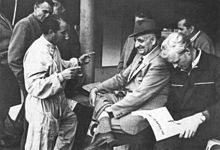Enzo Ferrari
The family lived in via Paolo Ferrari n°85, next to the mechanical workshop founded by Alfredo, who worked for the nearby railways.
[5] Alfredo Senior was the son of a grocer from Carpi, and began a workshop fabricating metal parts at the family home.
Unlike his brother, he preferred working in his father's workshop and participated in the construction of the canopy at the Giulianova station in 1914.
When he was 10 he witnessed Felice Nazzaro's win at the 1908 Circuito di Bologna, an event which inspired him to become a racing driver.
On 23 November of the same year, he took part in the Targa Florio but had to retire after his car's fuel tank developed a leak.
[11] Deeply shocked by the death of Ugo Sivocci in 1923 and Antonio Ascari in 1925, Ferrari, by his admission, continued to race half-heartedly.
Following the birth of his son Alfredo (Dino) in 1932, Ferrari decided to retire and form a team of superstar drivers, including Giuseppe Campari and Tazio Nuvolari.
This team was called Scuderia Ferrari (founded by Enzo in 1929) and acted as a racing division for Alfa Romeo.
[14] Alfa Romeo agreed to partner with Ferrari's racing team until 1933, when financial constraints forced them to withdraw their support – a decision subsequently retracted thanks to the intervention of Pirelli.
Alfa Romeo decided to regain full control of its racing division, retaining Ferrari as Sporting Director.
After a disagreement with Alfa's managing director Ugo Gobbato, Ferrari left in 1939 and founded Auto-Avio Costruzioni, a company supplying parts to other racing teams.
The first major victory came at the 1949 24 Hours of Le Mans, with a Ferrari 166 MM driven by Luigi Chinetti and (Baron Selsdon of Scotland) Peter Mitchell-Thomson.
In 1950 Ferrari enrolled in the newly born Drivers World Championship and is the only team to remain continuously present since its introduction.
In 1953 Ferrari made his only attempt at the Indianapolis 500, but the car driven by Ascari crashed on lap 41 of the race.
[17] In order to finance his racing endeavors in Formula One as well as in other events such as the Mille Miglia and Le Mans, the company started selling sports cars.
[citation needed] Ferrari's decision to continue racing in the Mille Miglia brought the company new victories and greatly increased public recognition.
However, increasing speeds, poor roads, and nonexistent crowd protection eventually spelled disaster for both the race and Ferrari.
In response, Enzo Ferrari and Englebert, the tyre manufacturer, were charged with manslaughter in a lengthy criminal prosecution that was finally dismissed in 1961.
[18] Deeply unsatisfied with the way motorsports were covered in the Italian press, in 1961 Ferrari supported Bologna-based publisher Luciano Conti's decision to start a new publication, Autosprint.
Following a rather weak title defence of Phil Hill's 1961 world title, sales manager Girolamo Gardini, together with manager Romolo Tavoni, chief engineer Carlo Chiti, sports car development chief Giotto Bizzarrini and other key figures in the company left Ferrari to found the rival car manufacturer and racing team Automobili Turismo e Sport (ATS).
Based in Bologna, and financially supported by Count Giovanni Volpi, ATS managed to lure away Phil Hill and Giancarlo Baghetti from Ferrari, who responded by promoting junior engineers like Mauro Forghieri, Sergio Scaglietti and Giampaolo Dallara,[20] and hiring Ludovico Scarfiotti, Lorenzo Bandini, Willy Mairesse and John Surtees to drive his Formula One cars.
The mid-engined Dino racers laid the foundation for Forghieri's dominant 250-powered 250 P. John Surtees won the world title in 1964 following a tense battle with Jim Clark and Graham Hill.
"[22] By the end of the 1960s, increasing financial difficulties and the problem of racing in many categories and having to meet new safety and clean air emissions requirement for road car production and development, caused Ferrari to start looking for a business partner.
[26] These feelings were reinforced after the 1979 French Grand Prix when Villeneuve finished second after an intense battle with René Arnoux.
Although such a high death toll was not unusual in motor racing in those days, the Vatican newspaper L'Osservatore Romano described Ferrari as being like the god Saturn, who consumed his own sons.
However, his longtime friend and company accountant, Carlo Benzi, related that privately Ferrari would say that "the car was the reason for any success".
[32] Following the deaths of Giuseppe Campari in 1933 and Alberto Ascari in 1955, both of whom he had a strong personal relationship with, he chose not to get too close to his drivers, out of fear of emotionally hurting himself.
According to Yates, Ferrari once remarked to racing manager Romolo Tavoni that "a man should always have two wives", and at one point in 1961, when he was dating three women simultaneously, he wrote, "I am convinced that when a man tells a woman he loves her, he only means that he desires her and that the only perfect love in this world is that of a father for his son", a comment that came several years after the death of his first son.
[37] Ferrari and Laura's one son, Alfredo "Dino", who was born in 1932 and groomed as Enzo's successor, suffered from ill-health and died from muscular dystrophy in 1956.
According to Yates, "There is no question that at some point in the late 1950s, Laura Ferrari discovered her husband's second life", and openly derided him as a "bastard" when she saw him in a factory.





